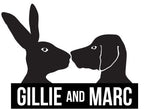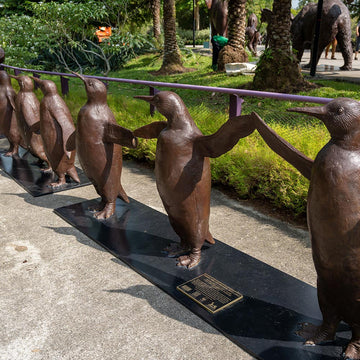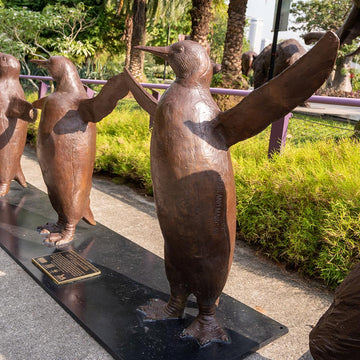Dimensions
Sculpture
39.4 x 393.7 x 2.2 inch (H*L*W) 1322.8lbs
1 x 10 x 1m (H*L*W) 600kgs
Base
354.3 x 39.4inch (L*W)
9 x 1m (L* W)
Medium
Bronze
Style
Contemporary Sculpture, Wildlife, Activist Art
Edition Number
/6
Description
This group of men have had a tough 2 months. They have survived freezing temperatures, storms so intense it’s impossible to see anything, and no food. But it’s all been worth it. They passed their precious baby which they watched hatch on their feet to their partner, and now it’s time to kick back from daddy-duty and fill their tummies. They have always had to be careful on these journeys, they aren’t the only hungry ones. Orcas and leopard seals are waiting for their arrival. They must be acrobats in the water to avoid them. But they can’t avoid the humans taking their food. The humans never seem to have enough fish and don’t like to share.
The largest of all the penguins, these beautiful birds make their home in one of the most inhospitable places in the world, Antarctica. These hardy birds are like no other. They can dive deeper than any other bird (500m), last without eating for longer (4 months) and is the only bird that breeds on the ice, during winter! With such extreme habits in such an extreme environment, these birds are fascinating.
With temperatures dropping down to -60 °C, these birds must work together to survive. They huddle together in a big group using their collective body heat to give the penguins in the centre protection from the wind. Once a penguin in the middle gets nice and warm it moves itself to the outside to give others a turn. But they also have special adaptations that help them out. They are naturally well insulated with body fat and several layers of feathers. They are also adapted to their deep, freezing dives which can last for around 20 minutes. With unusually structured haemoglobin which allows them to function with low oxygen levels, solid bones to help with the intense changes in pressure, and the ability to slow down their metabolism and shut down non-essential organs, these birds can achieve remarkable dives.
Emperor penguins have a very curious breeding system. They meet on the ice at the start of winter to breed. A few months later, the female lays her egg. This process makes her very hungry, so the male steps up to take his turn. She passes her egg from the tops of her feet to his, being extremely careful not to let the egg drop onto the freezing ice, before heading off to the open ocean to feed, a journey up to 80km away! The male is left to look after the egg, covering it with his feathered skin, called a brood pouch for the 65 days it takes to hatch, protecting it from the icy winds and storms. Once the two months is up, the female returns with a full belly, ready to regurgitate her food to the hungry chick. Since there is no fixed nest, she must use vocal calls to find her partner and chicks. Once found, the mother takes over childcare duties and the father hungrily sets off for his turn to eat. The mother must keep her chick warm in her brood pouch as they could die in just a few minutes if they are exposed. As the summer arrives the timing of the emperor penguins breeding makes sense. Just as the chicks are old enough to swim and fish by themselves, the summer sun breaks up the ice and open waters open up near the breeding site, ready for the young penguins first dip in the water.
It has been a recent development that the emperor penguin was moved from least concern to near threatened. The main threats this penguin faces are declining food, primarily caused by climate change and industrial fishing. They are also threatened with disease, habitat destruction, and the disturbance of breeding colonies by humans. Emperor penguins are very sensitive to changes in their climate. Studies have found that adult death rates increased in warmer periods with less sea-ice coverage, but when sea-ice increased, chick deaths increased. Scientists have predicted that with rising temperatures melting the sea ice, all colonies will see declining numbers through habitat loss and loss of krill, their primary food.
Artwork Features
Gillie and Marc love working in bronze for many reasons. Bronze is a very hardy material and will last forever. As experts in coloring bronze, Gillie and Marc enjoy experimenting with their sculptures, adding a splash of color to brighten the work, making it even more unique. > Read more
For every purchase of a bronze sculpture you will receive a certificate of authenticity, titled, signed, dated and editioned by the artists.
Care Instructions
Bronze is very easy to clean, allowing you to enjoy your precious sculpture with minimal upkeep. > Read more
Shipping, Returns and Refunds
Please visit this page to learn all about our policies. > Read more













